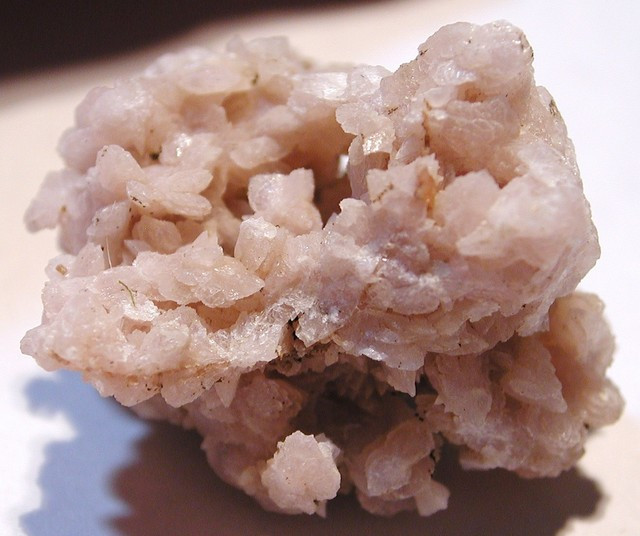
钠长石宝石:特性、含义、价值等
 钠长石是一种长石矿物,常见于其他宝石中,有时会产生独特的效果。钠长石本身也是宝石吗?没错!钠长石宝石通常呈白色半透明状。
钠长石是一种长石矿物,常见于其他宝石中,有时会产生独特的效果。钠长石本身也是宝石吗?没错!钠长石宝石通常呈白色半透明状。
钠长石是岩石还是矿物?它是一种矿物,尽管长石是地球表面约60%岩石的重要组成部分。钠长石是最丰富的长石矿物之一。
今天,我们将讨论您需要了解的有关钠长石的所有知识,包括它的象征意义、历史、价格等等!

什么是钠长石?
钠长石可用作半宝石、其他宝石的配料以及工业用途。从占星学角度来看,钠长石是水瓶座的星座石。
一种含有钠长石的宝石是特拉皮兹祖母绿,这是一种稀有而珍贵的哥伦比亚祖母绿,其中钠长石(或其他矿物)形成类似车轮辐条的六角图案。
钠长石也可构成绿柱石(一种用作宝石的岩石)。第三种含钠长石的宝石是天河石,它会形成白色条纹,但这些条纹通常会降低天河石的价值。
那么,钠长石在工业上有什么用途呢?钠长石最常见的工业用途是制造玻璃、陶瓷、磨料和耐火产品。
钠长石等长石矿物对土壤营养也至关重要。它们通常在地表风化,为土壤提供植物生长所需的养分。风化作用还常常形成对农业同样重要的粘土矿物,以及牙膏等研磨材料和陶器、陶瓷等装饰品。
钠长石规格和特性
几乎所有类型的长石都分为两大系列:钾长石(或碱性长石)和斜长石。钠长石矿物属于斜长石系列,也称为钙长石和钠长石系统。
斜长石矿物可以通过其两条解理线上的蚀刻凹槽(条纹)来区分。它们都是钠钙铝硅酸盐,只是钠和钙的含量有所不同。
钠长石至少含有90%的钠,但几乎不含钙。换句话说,钙长石(富含钙的斜长石对应物)在钠长石的成分中所占比例不到10%。纯钠长石的化学式为NaAlSi3O,但大多数钠长石样本并不纯净。
如果钾取代钠长石中10%或更少的钠含量,该矿物就变成了斜长石。斜长石有时被认为是富含钾的钠长石的一种。
其他斜长石矿物包括钙长石、中长石、斜长石、拉长石和斜长石。
以下是钠长石的其余属性:
莫氏硬度:6-6.5
颜色:无色、白色、粉色、红色、黄色、绿色、灰色
晶体结构:三斜
光泽:玻璃光泽至珍珠光泽,裂解处呈珍珠光泽
透明度:透明至不透明
折射率:1.52-1.54
密度:2.57-2.69
解理:[001] 上完美;[010] 上非常好;[110] 上不完美/不明显
断口:不规则至贝壳状
条痕:白色
发光:有时荧光 - 在长波紫外线下呈白色;肯尼亚材料在 X 射线下呈柠檬绿色
多色性:无
光学效果:有时有猫眼效应
钠长石的种类
钠长石有几种类型,还有一些部分由钠长石组成的宝石,我们将在下面讨论它们。
磷灰石
 图片来源:彩虹色长石-奥长石 | Flickr
图片来源:彩虹色长石-奥长石 | Flickr
磷灰石是一种白色或蓝色的钠长石,含有钠长石,层状结构偶尔会产生虹彩,甚至青白光彩(内部发光)。
它的名字来源于希腊语peristera ,意为“鸽子”,因为鸽子颈部羽毛的虹彩与紫水晶的虹彩相似。
克利夫兰石
 图片来源:Parent Géry | Creative Commons Attribution-Share Alike 3.0 Unported 许可证
图片来源:Parent Géry | Creative Commons Attribution-Share Alike 3.0 Unported 许可证
克利夫兰石是一种板状钠长石,由薄板状(类似桌子)层层叠叠构成。其曾用名包括“克利夫兰石”和“粒状辐射钠长石”。
月光石

月光石是一种常见的蓝白色宝石,以其乳白色的半透明色、珍珠般的光泽和独特的光泽而闻名。它也可以呈现其他各种颜色,例如橙色、灰色和绿色(仅举几例),但白色是最常见的。
这些宝石并非单纯由钠长石构成,而是由钠长石和正长石交替层层构成。这些层层结构除了构成月光石的结构外,还通过一种名为青白光彩的现象,使光线看起来像是从宝石内部散发出来的。
拉长石和光谱石

拉长石及其全谱芬兰品种光谱石由30-50%的钠长石和50-70%的斜长石组成。与之前的品种一样,这两种长石层状排列,形成了一种独特的虹彩,被称为拉长石晕彩。
莫西西

莫西西是一种罕见的亮绿色玉石,带有黑色和深绿色的纹理。它是由钠长石、硬玉和其他矿物组成的岩石。其商品名包括“翡翠钠长石”和“绿绿玉”,但绿绿玉实际上是一种外观相似的硬玉。
钠长石的意义和历史
钠长石象征着解放、自信以及在艰难时期的韧性。“钠长石”一词源于拉丁语“ albus ”,意为“白色”,因其典型的白色光泽而得名。
钠长石的一些历史别名包括:
方解石
基泽尔普拉特
柱状节理
隐晶/隐长石
白长石
白黑
奥拉菲特
特塔尔丁
钠长石
酸性斜长石
钠长斜长石
钠斜长石
钠长石
钠长石
这种矿物的正式发现发生在 1815 年,当时瑞典化学家 Johan Gottlieb Gahn 和 Jöns Jacob Berzelius 描述了来自瑞典达拉纳的样本。
有些品种,尤其是“花西西”(Maw sit sit),是近代才发现的。“花西西”直到1963年才被发现,当时瑞士宝石学家爱德华·古柏林(Edward Gubelin)在缅甸发现了这种矿物。

钠长石的治疗功效
与所有宝石一样,钠长石的颜色也对其作为疗愈石的功效起到一定作用。大多数钠长石呈无色至白色,与其他白色宝石一样,具有净化心灵、净化心灵的功效。
粉红色钠长石也是一个受欢迎的选择,它与其他粉红色宝石一起促进自爱、浪漫和谐和对他人的同情。
那么,钠长石在身体、情感和脉轮领域提供什么呢?
身体康复
钠长石对身体的益处与其对情绪的益处类似,主要集中在大脑方面。钠长石晶体被认为可以改善记忆力,并治疗痴呆、偏头痛和中风等脑部疾病。
此外,据说长石通常可以治疗关节炎、脱发和皮肤病。
情绪疗愈
大脑是我们情绪的中心,而钠长石对精神健康有着奇妙的益处。它以刺激思维、促进清晰思考而闻名。
此外,据说钠长石可以提供动力并增强直觉,同时消除自我怀疑、脑雾或犹豫不决。
脉轮疗愈
脉轮疗愈旨在解决因身体某个能量点(脉轮)受阻而引起的负面症状。其目标是打开脉轮,恢复整个系统的平衡。
钠长石是顶轮的脉轮石,位于头部正上方,能量旋转的冠状结构中。顶轮是最高的精神中心。感觉思想封闭或与世隔绝是顶轮阻塞的症状。用钠长石打开顶轮,可以提升觉知力,并与精神力量建立联系。

钠长石宝石特性
宝石专家会根据宝石的几个不同类别来综合评估其价值。就钠长石而言,这些价值属性包括颜色、切工、净度和克拉重量。
首先,钠长石是什么颜色的?
颜色
钠长石的颜色通常为无色至白色,但也可以是粉红色、灰色、红色、绿色、黄色、蓝色,甚至黑色。
这些颜色(除了纯钠长石的无色和白色色调外)是由内含物造成的。例如,绿色样本的颜色通常来自铬翡翠。有时,宝石会与其他宝石共生,例如钠长石中的红宝石通常呈灰色,带有红色斑点。
由于大多数白色钠长石对于大多数买家来说有些无趣,因此任何有趣的颜色都会提高宝石的价值。
切
虽然刻面钠长石并不常见,但却价值不菲。大多数钠长石都是从钠长石的尖端切割而成的无色宝石。
大多数钠长石品种都被切割成凸圆形,包括上文提到的钠长石中的红宝石和猫眼钠长石。此外,钠长石晶体通常以未切割的原石形式出售。
明晰
净度描述宝石中可见内含物的数量。钠长石通常包含在宝石中,因此可能被评为II型或II型彩色宝石净度等级。
虽然绿帘石等常见内含物通常会降低钠长石的价值,但如果纤维内含物能赋予宝石猫眼光泽,即“猫眼”效果,则会增加钠长石的价值。
克拉重量
净度良好的刻面钠长石宝石通常只有1-3克拉。任何比这更大的宝石都会价值更高。
猫眼石钠长石的尺寸已达到 50 克拉。
在被切割或定型之前,钠长石晶体是如何形成的?

钠长石的形成和来源
根据钠长石的形成,钠长石可分为两种:低钠长石和高钠长石(或方钠长石)。高钠长石体积较大,可在低钠长石加热至 1,380 °F(750 °C)以上时形成。
如果温度超过1,920华氏度(1,050摄氏度),晶体就会变成单斜晶系,并被归类为单钠长石。超过2,010至2,050华氏度(1,100至1,120摄氏度),钠长石就会熔化。
有趣的是,在陨石坑中也发现了高钠长石!
总体而言,钠长石是在低温下形成的火成岩内部形成的。它最常见于伟晶岩、花岗岩和绿片岩中。
采矿地点
钠长石产于何处?宝石级钠长石主要产自缅甸、马达加斯加和巴西。美国弗吉尼亚州也因出产高品质、可刻面、无色的钠长石晶体而闻名。克利夫兰石的重要产地是巴西、美国南达科他州和弗吉尼亚州。
其他重要的钠长石宝石来源包括:
奥地利
加拿大(钠长石和磷长石)
肯尼亚
马达加斯加
斯堪的纳维亚半岛
南非
关键问题时间:钠长石的价值是多少?

钠长石的价格和价值
刻面钠长石最为稀有,尤其是彩色钠长石,因此价格也最为昂贵。大多数刻面钠长石呈淡粉色,价格从每克拉 50 美元到近 300 美元不等,但大多数价格在每克拉 100 美元左右。
大多数以钠长石为特色的凸圆形宝石和滚石都是钠长石中的红宝石,每颗价格在5美元到40美元之间。月光石凸圆形宝石的价格也差不多。
最昂贵的品种是 maw sit sit(有时被标记为绿宝石或玉钠长石),每颗凸圆形宝石的价格约为 500 至 800 美元,或每克拉的价格为 12 至 25 美元。
钠长石原石几乎总是与其他宝石混镶,这意味着其他晶体的价值会影响原石的价格。例如,钠长石与托帕石原石的镶嵌价格为每克拉0.15至0.30美元,而钠长石与亮蓝色或绿色碧玺的镶嵌价格则高达每克拉50美元。
钠长石的保养和维护
钠长石需要相当标准的宝石护理,尽管其解理可能导致宝石在受到坚硬、锋利的撞击时破裂。为了降低这种风险,我们建议购买带有保护性镶嵌的钠长石首饰。
用蘸有温水和温和肥皂的软牙刷安全地清洁钠长石。冲洗掉任何肥皂残留物,然后用柔软的超细纤维布擦干。
将钠长石与其他宝石分开存放,以免刮伤。最好将它们存放在干燥的环境中,因为潮湿的环境可能会导致原石随着时间的推移出现类似风化的损坏。

被钠长石吸引?
虽然钠长石可能不如其他宝石那样闪耀夺目,但它们却拥有丰富的多样性和独特的光学效果,例如虹彩和青白光彩。钠长石虽然是一种常见的矿物,却格外引人注目,总能吸引路人的目光!
搜索Gemstone Encyclopedia
最新的文章
彩虹格纹日光石是一种长石,由于内部含有各种包裹体,呈现出三种绚丽的光学效应。它绚丽多彩的光泽和格纹图案使其成为收藏家梦寐以求的珍宝!
12th Jan 2026
文章分类
How To's is where you will find helpful articles from gem Rock Auctions on how to cut gemstones, select gemstones and buy gemstones.
9文章数
